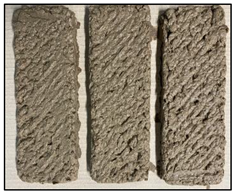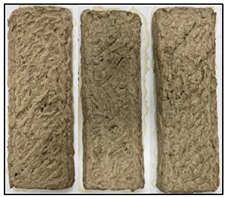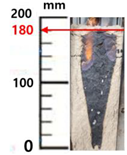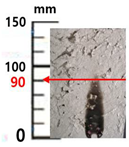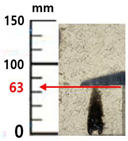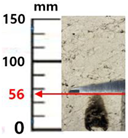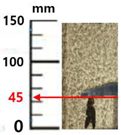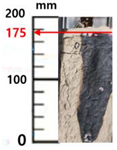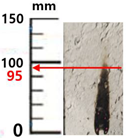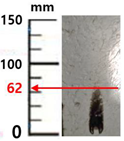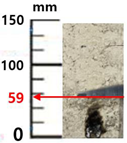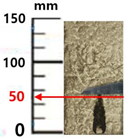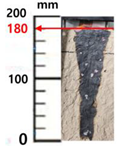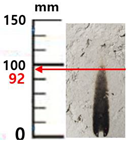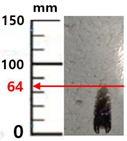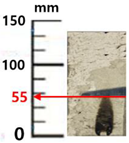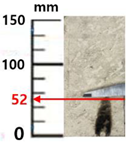Abstract
The increase in non-face-to-face lifestyles due to COVID-19 worldwide have shown an increase in delivery services. The number of parcels in 2020 was 3.373 billion, an increase of 20.9% from 2.788 billion in 2019. This phenomenon increased delivery box waste. Against this background, this study attempted to develop building materials from the recycling of delivery boxes. In this study, the self-developed WC (wet cellulose) 3D printer confirmed the standardization and uniform performance of the sample by filling the material supply cylinder with cellulose filaments and spraying the composite material through a 10 mm nozzle. The cellulose filament for a WC 3D printer is based on cellulose extracted from wastepaper, and a cellulose filament composite material is used by mixing additives. After manufacturing a specimen using the WC 3D printer, a reliability test for the flame-retardant performance of the material was conducted according to the ISO 11925-2 test method. As a result of the experiment, flame-retardant performance was confirmed at a 40 wt% or greater ceramic binder content. In addition, the WC 3D printer achieved accurate test results by producing specimens with uniform physical properties. In addition, we confirmed that 3D-printed WC can be used to develop customized building materials that can prevent fire spread.
1. Introduction
The construction finishing method mainly used at home and abroad is EIFS (Exterior insulation and finish system). EIFS uses an inexpensive aluminum composite panel as a combustible outer-wall finishing material. As a result, EIFS materials frequently cause large-scale fire accidents in buildings.
As an example, in October 2010, the Busan Wooshin Golden Suite fire broke out in Korea. The cause of the fire in the Busan suite was identified as a short circuit in a cleaning room on the fourth floor of the Marine City officetel. What is unusual about the Busan Suite fire is that the fire spread from the ignition point on the fourth floor to the rooftop on the 38th floor in just 30 min. The cause of this rapid spread of the fire was found to be the combustible aluminum composite panels used as building finishing materials. Aluminum composite panels used as finishing materials for outer walls have various advantages. The main advantages are that they are inexpensive and have an excellent design, good energy efficiency, and simple construction [1].
Secondly, the same type of fire broke out in the parking lot of the Daebong Green apartment building in Gyeonggi-do in January 2015. This time, the apartment fire killed 5 people and injured 125 people. In this case, combustible building finishes were used inside and outside the apartments that caught fire. Since 2009, Korea has allowed the use of EFIS components on the outer walls of buildings to provide a stable residential environment and inexpensive small houses for one to two people. Accordingly, it is estimated that about 600,000 households in Korea are currently exposed to a fire risk caused by combustible building materials on the outer walls of their buildings [2].
As a third example, the same kind of fire broke out at Grenfell Tower in June 2017. The Grenfell Tower fire was caused by a short circuit in a refrigerator on the fourth floor of the building, killing 72 people. Even in this fire, the reason for the rapid spread of the fire was found to be a combustible complex panel installed on the outer wall of the building. All 24 floors of the Grenfell Tower were remodeled in 2016, including the exterior of the building. Many of the casualties in the Grenfell fire were caused by the rapid vertical propagation of flames to the higher floors of the building, as combustible exterior materials were attached to the outer walls of the building and sprinklers were not installed at the time of remodeling [3].
What this series of fire accidents have in common is that construction was carried out using flammable outer-wall finishes, and these wall finishes became a medium to increase the spread of fires [4]. The main cause of fire material damage and human injury is the use of low-cost combustible building materials, prioritizing economic feasibility and construction convenience. Therefore, the flame-retardant performance of building materials is an essential consideration to prevent the spread of fire [5].
Among these combustible building materials, materials derived from polymer chemicals are still problematic because of their high risk and frequency of use. The most common combustible building materials are polyurethane-based products. The reason for using polyurethane-based products is that the resin and additives are easy to mix, their thermal conductivity is low (0.025 W/m·K), and mass production is possible at a low production cost [6]. The production method of polyurethane-based products has not changed significantly for 50 years. Currently, research on eco-friendly products that are biodegradable in soil and supplementary research on these materials’ vulnerability to fire is underway [7,8].
To meet the demands of the times, future building materials need creative development that combines safety and convenience as well as material characteristics that can preserve the global environment. From a fire point of view, future building materials should aim to secure evacuees’ survival time by reducing toxic combustion gases and reducing the diffusion rate of fires when combustible materials are ignited [9]. In addition, they should be light, safe, and easy to use. In terms of the environment, their disposal requires an eco-friendly process that does not harm the global environment [10]. The development of new building materials has been carried out in various engineering fields.
Amat et al. conducted a study to develop a refractory partition based on the oil extraction process’ waste residual biomass EFP (Empty Eruit Bunch). According to the results of this study, the developed biomass material (EFB) panel board showed fire resistance at a compressive strength of 3.535 MPa for more than 2 h [11].
Rie et al., after producing a specimen comprising a phosphorus flame retardant in a paper honeycomb structure, conducted a flame-retardancy evaluation using a cone calorimeter. The flame-retardant performance evaluation using a cone calorimeter showed an 84.2% improvement for the flame-retardant-impregnated specimen compared to the untreated specimen [12].
El-Sabour and Mona Asms made multipurpose cardboard sheets by recycling wastepaper, newspapers, and magazines. The cardboard sheets were subjected to a flame-retardant treatment at concentrations of 1%, 3%, and 5% wt/vol of organic phosphate compounds. As a result of the experiment, it was confirmed that the 3% (wt/vol) organic phosphate flame-retardant treatment was the minimum concentration required to achieve flame retardancy in the cardboard [13].
Basri et al. conducted a study on the correlation between the fire resistance and the compressive strength of rice husk (RHA)-based geopolymer binder (GB) synthetic material. The factors selected in this study were rice husk ash/active alkali solution (RHA/AA) ratio and sodium hydroxide (NaOH) concentration. RHA-based GB has excellent fire resistance (slow, thermally stable combustion) and mechanical properties, making it highly suitable for use as an insulating material in various fields [14].
Zuo and Yuan manufactured aerogels to study the improvements in the insulation and pressure resistance of insulation materials. In this study, graphene oxide (GO), montmorillonite (MMT), and cellulose nanofibers (CNF) were used to make an aerogel using a vacuum freeze-drying method. According to the results, aerogels have the advantage of improving the insulation performance and flame-retardant performance by reducing the thermal conductivity of insulation materials [15].
Moreno et al. conducted a study on the production of refractory cellulose boards with a low density and moderate refractive strength by adding soybean protein, boric acid, and boron to wastepaper and using them as internal partitions without load. According to the results of the board component ratio impact study on flame retardancy (UL 94 horizontal combustion test), density (ASTMD1037-12), and flexural strength, the boards were reported to be suitable for use as flame-retardant building materials, with a density of 120–170 kg/m3 and flexural strength of 0.06–0.64 MPa [16].
Shanshan Zhang conducted a study on the flame retardancy of cellulose-based film materials. Bamboo-based cellulose nanofibers (B-PCNFs) were prepared through a simple two-step method consisting of phosphorylation and mechanical grinding. Compared to general cellulose films, BHL-PCNF films reported an 87.3% reduction in the peak heat release rate (PHRR) and an 86.6% reduction in total heat release (THR) [17].
Wang et al. conducted a study to measure the organophosphorus flame retardant (OPFR) concentration of products that used OPFRs for flame-retardant performance. As a result, OPFR concentrations differed significantly from 14.78 ng/g (putty powder) to 9,649,000 ng/g (expanded polystyrene panel (EPS)). The expected concentration of OPFR for interior decoration using nonwoven wallpaper was 330 times and 2110 times higher than when latex paint and diatomite were used, respectively [18]. In recent modern society, lifestyles have changed significantly due to COVID-19. In particular, the proliferation of contactless lifestyles has resulted in a rapid increase in courier services. [19] The number of deliveries in 2020 was 3.373 billion, an increase of 20.9% from 2.789 billion in 2019 [20]. Recycling wastepaper, which has increased with the increase in parcel delivery, saves 17 trees per ton (907 kg), reducing greenhouse gases in the atmosphere and reducing CO2. Against this background, this study attempted to develop flame-retardant building materials that can prevent the spread of fire by recycling the increasing amounts of wastepaper. In addition, the use of 3D printers, a key technology in the Fourth Industrial Revolution to meet the demands of the changing times, will allow production using materials in laboratories and homes as opposed to existing factory-oriented manufacturing.
3D-printer manufacturing technology refers to a change in the industry from one type of mass production to several types of small-volume production. It has the advantage of being able to produce various types of building materials and specimens in a short time with simple printing, independent of the existing mass-production-based manufacturing and assembly methods. Using a very precise and efficient extrusion lamination molding method, 3D printers can be used in various situations from precision structure manufacturing to building construction [21,22]. They are also used in the manufacture of precision electron refractory structures [23]. Therefore, in this study, various specimens were produced by applying a self-developed 3D-printer method.
In this research, specimens were manufactured using a self-developed 3D printer, a composite material prepared by mixing wastepaper (corrugated cardboard) for manufacturing parcel boxes, and a ceramic binder. The printed specimen was tested for the reliability of the material’s flame-retardant performance using the ISO 11925-2 experiment method.
2. Materials and Method
2.1. Main Materials and Additives
This experiment was prepared by mixing the main material of cellulose, extracted from wastepaper, with a ceramic binder. The composite material was produced and manufactured as a specimen using a wet cellulose (WC) 3D printer as a cellulose filament.
The wastepaper used for parcel boxes was provided in the form of corrugated cardboard through the recycling center. As an additive, a ceramic binder and PAM (PolyAcrylaMide) were used.
The ceramic binder of this study was the main additive, and ‘FP-100’ produced by Sunjin Chemical Korea was used. The ceramic binder components consisted of 48% MgO, 17% SiO2, 14.6% Al2O3, 12% Illite, 7% ZrO2, 1% Al2O3, 0.8% Fe2O3, and 0.6% CaO. The ceramic binder was used to improve the flame retardancy and rigidity of the composite material. The PAM used was ‘Dakpul’, produced by OnGoeulhanji.
The prepared specimen was tested for flame retardancy through ISO-11925-2. Figure 1 shows the flowchart of the sample production process and the order of experiments.

Figure 1.
Cellulose test specimen production flowchart from packaging waste.
2.2. Wet Cellulose 3D Printer
For specimen production, a self-developed WC 3D printer was used to achieve a standardized uniform performance. The WC 3D printer’s work surface moved along the Y-axis using a motor and a BL touch sensor was used to adjust the zero point. The nozzle transfer device used a motor and belt to move along the X-axis and Z-axis and used a limit sensor to adjust the zero point. The cellulose filament was filled in a material supply cylinder and stacked by spraying an extrusion force to a nozzle of 10 mm through upper lead-screw motor rotational force. The WC 3D printer included automatic zeroing. The zero position was marked in the center of the work surface and could be checked from the outside when the printer’s automatic-zero adjustment devices were operated. If it was necessary to change the position, we changed the position of the limit sensor on the X-axis and Z-axis and changed the position of the BL touch sensor on the Y-axis. Figure 2 shows the WC 3D printer and the main structure.

Figure 2.
WC (wet cellulose) 3D printer and main structure.
2.3. Cellulose Filament Production
Pulping of the wastepaper was performed by separating the wastepaper from water. The operating conditions of the pulping equipment were set to a capacity of 16 L with a motor speed of 360 RPM and an operating time of 60 min. Figure 3 shows the pulp equipment and the resulting pulp. The pulper dissociated the paper weight/water weight ratio (wt%) at a ratio of 1/2.5 to 3 times.

Figure 3.
(a) Pulper equipment, (b) paper decomposition result.
A composite material was prepared by mixing additives with pulped wastepaper. The composite material was used as a WC 3D printer cellulose filament. Table 1 shows the cellulose cylinder structure and the cylinder filled with the filament.

Table 1.
Cellulose filament cylinder structure and picture.
Cellulose filaments for 3D printing were based on 100 wt% wastepaper. The additives were adjusted at a weight ratio of up to 100 wt% of the wastepaper, and the unit was weight% (wt%). The specimen was prepared by increasing the amount of ceramic binder, added at a ratio of 0 to 50 wt%. Through the preliminary experiment, it was confirmed that the manufacture was a meaningful result with a content ratio of the ceramic binder of 20 wt% or more, and a specimen with 10 wt% was not manufactured. In addition, PAM was added as a dispersion material into the 3D-printing extrusion and mixture material at 5 wt%. Table 2 shows the specimen mixture composition applied to the experiment; three specimens were produced for each composition.

Table 2.
Composition of wet cellulose 3D printer filament (wt%).
2.4. WC (Wet Cellulose) 3D Printing
First, 3D printing was conducted by designing the size and shape of the specimen using ‘Design123’ software. The ISO 11925-2 specimen was designed to have a size of 250 mm × 90 mm × 20 mm.
The second generated design file was programmed with output conditions such as cellulose filament printer pressure output and work surface transfer speed through the ‘Cura 15.04.6’ program, and the two-layer output was produced using the 10 mm nozzle of the WC 3D printer. The 3D-printed specimen was dried for 48 h in a dryer at 60 °C. Table 3 shows the appearance of the output specimen before and after drying. From the images in Table 3, it was confirmed that the specimen before drying contained a lot of moisture for 3D printing, but this did not cause shape deformation, as the moisture evaporated during the drying process.

Table 3.
Printed specimen before and after drying.
2.5. Specimens and Physical Characteristics
The average weight of a specimen before drying was 784 g. Figure 4 shows the average weight of a specimen after drying, which was 113 g. The filling process of the cylinder filament was performed manually. In this process, it is assumed that a fine air layer was formed inside the cylinder. The amount of filament extrusion of the printer was associated with the number of rotations of the motor. Therefore, it is presumed that although the motor was appropriately rotated and extruded from the cylinder, fine air came out instead of the filament. It is assumed that a weight error occurred at this point, and the error range was confirmed to be ±1 g. The moisture content was calculated based on Equation (1) by comparing the weight before and after the specimen was dried. Figure 5a shows the average functional rate of the specimens, which was confirmed to be 85.5%. The density before drying the specimens was 1.21 g/cm3, and the standard deviation was ±0.22 g/cm3. Figure 5b shows the average density after drying, which was 0.26 g/cm3 with a standard deviation of ±0.02 g/cm3. The moisture content and density confirmed that the physical properties of the specimens used in this test were uniform.
where MC = moisture content (%), Wm = weight of the specimen before drying, and Wd = weight of the specimen after drying.
MC [%] = [(Wm − Wd)/Wm] × 100,

Figure 4.
Weight after drying a specimen.

Figure 5.
Density (a) and moisture content (b) after drying the specimen.
2.6. Description of ISO 11925-2 Test
The tests were conducted by BS EN ISO 11925-2 “Reaction to Fire test—Flammability of building products subjected to direct impact of flames—Part 2: Single flame source test”. Tests were conducted according to the procedures specified for the flammability of building products. Figure 6 shows the schematic diagram of the experimental setup.

Figure 6.
(a) An ISO 11925-2 experimental device, (b) a prepared test, (c) an ISO 11925-2 test.
The purpose of the ISO 11925-2 test method applied in this experiment was to investigate the vertical fire propagation characteristics of materials inside and outside a building. The specimen was pretreated at 23 (±2) °C and 50 (±5)% relative humidity for two days using a constant temperature and humidity (constant humidity spec). The pretreated specimen was exposed to flames for 30 s using an ignition source inclined 45 degrees relative to the vertical axis. The ignition source used in this experiment was set up to have a height of 21 mm by adjusting the gas supply valve in a vertical position using commercial propane (between 10 KPa and 50 KPa) with 95% purity. The specimen was positioned and fixed between two U-shaped frames made of stainless steel; Figure 6b represents a reference line 40 mm from the bottom surface and a reference line 150 mm above the first reference line. The experiment was terminated after 30 s, when the timer was activated at 45 degrees and the flame met the specimen.
The experiment was installed vertically and had the ability to heat directly in a single frame regardless of radiant heat. Therefore, in this experiment, the fire protection performance could be evaluated by directly exposing the building materials to flames and measuring and comparing the carbonized area.
At the end of the experiment, the performance standard was evaluated by applying the standard of EN 13501-1 [24].
3. Results of ISO 11925-2 Test
Table 4 shows images taken after a flame was applied to the specimens for 30 s, indicating the damage height (mm), the occurrence of afterglow, and the changes to the specimen.

Table 4.
Result of ISO 11925-2 test.
As a result of the ISO 11925-2 test, the height of the flame propagation by the specimens was confirmed. Table 5 shows the results of the flame after coming into contact with the surface of the specimen for each ceramic binder content for 30 s. After flame contact, afterglow was confirmed in specimens with a ceramic binder mixing ratio of 30 wt% or less. In one of the eight specimens in which an afterglow occurred, the afterglow evolved naturally, and seven specimens were confirmed to be completely burned. It was confirmed that the afterglow in the three 30 wt% specimens was extinguished naturally over time. The flame propagation height was 150 mm or less, which is the standard of EN 13501-1, in all specimens to which a ceramic binder was added. The specimen produced using only the paper showed a flame propagation height of more than 150 mm. The average damage height according to the ceramic content of the sample was 0 wt% 176.7 mm, 20 wt% 92.3 mm, 30 wt% 63 mm, 40 wt 56.7 mm, and 50 wt% 49 mm, which confirmed that the carbonization length decreased as the content of the ceramic binder increased. According to the ISO 11925-2 test, it was confirmed that the damage height, which is a performance standard of EN 13501-1, was measured within 150 mm without afterglow in a 40 wt% ceramic binder sample, and thus the minimum content was ensured for flame retardancy.

Table 5.
ISO 11925-2 test results.
4. Discussion
Specimens manufactured using only paper were evaluated to have no flame-retardant performance according to the performance standards of EN 13501-1 in the ISO 11925-2 test, because the damage height exceeded 150 mm. Therefore, the manufacture of building materials using only wastepaper does not reduce the diffusion rate of flames. However, in the specimen to which the ceramic binder was added, the damage height was confirmed to be within 150 mm, which met the EN 13501-1 performance criteria.
Additionally, a sample with 30 wt% or less of the ceramic binder was judged to be unable to be used as a building material because it displayed the same hole pattern of afterglow as the fire propagation characteristics of the general combustible material.
Figure 7 shows the damage height according to the amount of ceramic binder added. Through this, it was confirmed that the ceramic binder helped in flame-retardancy performance. It is expected that the construction material of wastepaper with the added ceramic binder used in this experiment will have the effect of reducing the vertical fire diffusion rate when a fire occurs.

Figure 7.
The extent of damage height in ISO 11925-2 test.
The damage height of the samples to which 20 wt% or more of the ceramic binder was added was less than 150 mm. However, an afterglow occurred in the samples with ceramic binder contents of 20 wt% and 30 wt%, and the entire sample was burned. Therefore, in this study, a specimen containing 40% by weight of the ceramic binder prevented the vertical diffusion of fire and did not generate an afterglow, and so this was determined as the minimum content.
In the event of a fire, a delay in the vertical diffusion rate of the fire is judged as a fundamental countermeasure to reduce human casualties and property damage. As in this study, the development of building materials based on waste recirculation that can suppress the spread of fire is considered an essential element of modern society.
5. Conclusions
Through this study, the following conclusions were made.
First, a specimen manufactured with the self-developed Wet Cellulose 3D Printer had a density standard deviation of ±0.02 g/cm3 after drying, which was verified to be a uniform physical property value, and through this, it was possible to obtain accurate test results.
Second, to produce and output a cellulose-based filament, the content of the filament must be 80% or greater, based on a 10 mm nozzle output.
Third, the ISO 11925-2 test results satisfied the EN 13501-1 performance standard for flame propagation under the additional condition of 30 wt% or less of the ceramic binder but did not meet the flame retardant performance standard, due to the occurrence of afterglow.
Finally, it was confirmed that cellulose filaments containing 40 wt% or more of the ceramic binder could produce building materials of various shapes that are capable of preventing fire diffusion using a WC 3D printer.
Through this study, the possibility of developing building materials with flame-retardant properties using wastepaper-based cellulose was confirmed. Additionally, further research on the flame-retardant performance of customized building materials produced using a WC 3D printer is needed.
Author Contributions
Conceptualization, D.R.; methodology, D.R.; software, D.P.; validation, J.H. and D.P.; analysis, D.R.; resources, D.P.; writing, J.H., D.P. and S.K.; review and editing, D.R. and J.H.; visualization, D.P. and S.K.; supervision, D.R.; project administration, D.R.; funding acquisition, D.R. All authors have read and agreed to the published version of the manuscript.
Funding
This research received no external funding.
Institutional Review Board Statement
Not applicable.
Informed Consent Statement
Not applicable.
Data Availability Statement
The data presented in this study are available on request from the corresponding author.
Acknowledgments
This work was supported by an Incheon National University Research Grant in 2020.
Conflicts of Interest
The authors declare no conflict of interest.
References
- Golden Luxury Housing in Marine City. Busan Ilbo Newspaper. Available online: https://news.naver.com/main/read.nhn?mode=LSD&mid=sec&sid1=102&oid=082&aid=0000270579 (accessed on 2 October 2010).
- Fire at Uijeongbu Apartment... “Two died, 75 injured”, Yonhap News Agency. Yonhap News Agency. Available online: https://www.yna.co.kr/view/AKR20150110026253060?input=1195m (accessed on 10 January 2015).
- Grenfell Tower: What Happened. BBC News. Available online: https://www.bbc.com/news/uk-40301289 (accessed on 29 October 2019).
- Mitchener, G. Impact of Grenfell Tower Fire Disaster on Polyisocyanurate Industry. Polimery 2018, 63, 716–722. [Google Scholar] [CrossRef]
- Naser, M.Z.; Thavarajah, P. Ceramic Tiles as Sustainable, Functional and Insulating Materials to Mitigate Fire Damage. Adv. Appl. Ceram. 2021, 120, 227–239. [Google Scholar] [CrossRef]
- Wi, S.; Kang, Y.; Yang, S.; Kim, Y.U.; Kim, S. Hazard Evaluation of Indoor Environment Based on Long-Term Pollutant Emission Characteristics of Building Insulation Materials: An Empirical Study. Environ. Pollut. 2021, 285, 117223. [Google Scholar] [CrossRef] [PubMed]
- Gunawan, N.R.; Tessman, M.; Schreiman, A.C.; Simkovsky, R.; Samoylov, A.A.; Neelakantan, N.K.; Bemis, T.A.; Burkart, M.D.; Pomeroy, R.S.; Mayfield, S.P. Rapid Biodegradation of Renewable Polyurethane Foams with Identification of Associated Microorganisms and Decomposition Products. Bioresour. Technol. Rep. 2020, 11, 100513. [Google Scholar] [CrossRef]
- Shao, X.; Du, Y.; Zheng, X.; Wang, J.; Wang, Y.; Zhao, S.; Xin, Z.; Li, L. Reduced Fire Hazards of Expandable Polystyrene Building Materials via Intumescent Flame-Retardant Coatings. J. Mater. Sci. 2020, 55, 7555–7572. [Google Scholar] [CrossRef]
- Kim, N.K.; Kang, Y.-S.; Rie, D.H. Estimating Toxic Harmfulness Based on Quantitative Analysis (I)—Factor Analysis of Harmfulness of Combustion Products on Building Materials. Fire Saf. J. 2019, 106, 80–87. [Google Scholar] [CrossRef]
- Basak, S.; Ali, S.W. Sustainable Fire Retardancy of Textiles Using Bio-Macromolecules. Polym. Degrad. Stabil. 2016, 133, 47–64. [Google Scholar] [CrossRef]
- Amat, R.C.; Ibrahim, N.M.; Rahim, N.L.; Tajudin, N.S.B.A.; Ahmad, K.R. Fire Resistance of Biomass Ash Panels Used for Internal Partitions in Buildings. Proc. Eng. 2013, 53, 52–57. [Google Scholar] [CrossRef] [Green Version]
- Rie, D.-H.; Moon, S.-W.; Lim, K.-B. Combustion and Thermal Properties of Paper Honeycomb: Treatment of Phosphorus-Based Flame Retardant Agents. J. Therm Anal. Calorim. 2012, 107, 535–539. [Google Scholar] [CrossRef]
- El-Sabour, M.A.; Mohamed, A.L.; El-Meligy, M.G.; Al-Shemy, M.T. Characterization of recycled waste papers treated with starch/organophosphorus-silane biocomposite flame retardant. Nordic Pulp Pap. Res. J. 2020, 36, 108–124. [Google Scholar] [CrossRef]
- Mohd Basri, M.S.; Mustapha, F.; Mazlan, N.; Ishak, M.R. Rice Husk Ash-Based Geopolymer Binder: Compressive Strength, Optimize Composition, FTIR Spectroscopy, Microstructural, and Potential as Fire-Retardant Material. Polymers 2021, 13, 4373. [Google Scholar] [CrossRef] [PubMed]
- Zuo, B.; Yuan, B. Flame-Retardant Cellulose Nanofiber Aerogel Modified with Graphene Oxide and Sodium Montmorillonite and Its Fire-Alarm Application. Polym. Adv. Technol. 2021, 32, 1877–1887. [Google Scholar] [CrossRef]
- Moreno, P.; Villamizar, N.; Perez, J.; Bayona, A.; Roman, J.; Moreno, N.; Cardozo, N.S.M. Fire-Resistant Cellulose Boards from Waste Newspaper, Boric Acid Salts and Protein Binders. Clean Technol. Environ. Policy 2021, 23, 1537–1546. [Google Scholar] [CrossRef]
- Zhang, S.; Li, S.-N.; Wu, Q.; Li, Q.; Huang, J.; Li, W.; Zhang, W.; Wang, S. Phosphorus Containing Group and Lignin toward Intrinsically Flame Retardant Cellulose Nanofibril-Based Film with Enhanced Mechanical Properties. Compos. Part. B Eng. 2021, 212, 108699. [Google Scholar] [CrossRef]
- Wang, Y.; Hou, M.; Zhang, Q.; Wu, X.; Zhao, H.; Xie, Q.; Chen, J. Organophosphorus Flame Retardants and Plasticizers in Building and Decoration Materials and Their Potential Burdens in Newly Decorated Houses in China. Environ. Sci. Technol. 2017, 51, 10991–10999. [Google Scholar] [CrossRef] [PubMed]
- Unnikrishnan, A.; Figliozzi, M.A. A Study of the Impact of COVID-19 on Home Delivery Purchases and Expenditures. Available online: https://archives.pdx.edu/ds/psu/33410. (accessed on 29 July 2020).
- “Corona raid” Had More than 3.3 Billion Packages Last Year. A 21% Surge. Chosun Biz. Available online: https://biz.chosun.com/site/data/html_dir/2021/02/19/2021021902282.html (accessed on 19 February 2021).
- Paul, S.C.; Tay, Y.W.D.; Panda, B.; Tan, M.J. Fresh and Hardened Properties of 3D Printable Cementitious Materials for Building and Construction. Arch. Civil Mech. Eng. 2018, 18, 311–319. [Google Scholar] [CrossRef]
- Smardzewski, J.; Wojciechowski, K.W. Response of Wood-Based Sandwich Beams with Three-Dimensional Lattice Core. Compos. Struct. 2019, 216, 340–349. [Google Scholar] [CrossRef]
- Vahabi, H.; Laoutid, F.; Mehrpouya, M.; Saeb, M.R.; Dubois, P. Flame Retardant Polymer Materials: An Update and the Future for 3D Printing Developments. Mater. Sci. Eng. R Rep. 2021, 144, 100604. [Google Scholar] [CrossRef]
- ISO 11925-2:2020; Reaction to Fire Tests. Ignitability of Products Subjected to Direct Impingement of Flame. Part 2, Single-Flame Source Test. British Standards Institution: Geneva, Switzerland, 2020.
Publisher’s Note: MDPI stays neutral with regard to jurisdictional claims in published maps and institutional affiliations. |
© 2022 by the authors. Licensee MDPI, Basel, Switzerland. This article is an open access article distributed under the terms and conditions of the Creative Commons Attribution (CC BY) license (https://creativecommons.org/licenses/by/4.0/).


